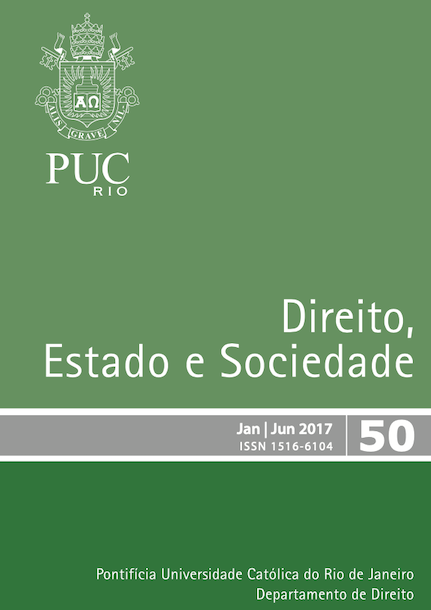O que Brown e Obergefell nos Ensinam sobre Contramajoritarismo? / What do Brown and Obergefell Teach us about Countermajoritarism?
DOI:
https://doi.org/10.17808/des.50.512Palavras-chave:
Suprema Corte dos EUA, Casamento Gay, Contramajoritarismo, Federalismo / U.S. Supreme Court, Gay Marriage, Countermajoritarism, FederalismResumo
O presente artigo propõe uma comparação entre Brown vs. Board of Education (1954) e Obergefell vs. Hodges (2015). A primeira decisão, por ser sensivelmente abstrata e influente no direito constitucional norte-americano, passou por um processo marcante de mitificação acerca de seu caráter contramajoritário. A segunda também protegeu uma minoria social com base na interpretação da cláusula de proteção igualitária e, assim, pode ser alvo desse mesmo fenômeno. Diante desse processo de mitificação, sustenta-se a hipótese de que há natureza majoritarista nas decisões de Brown e Obergefell. Embora ambas as decisões tenham protegido direitos de minorias sociais, tais mudanças interpretativas foram adiadas pela Suprema Corte norte-americana até que uma maioria qualificada de Estados já as tivesse implementado. A metodologia se baseou em dois parâmetros: o comportamento decisório da Corte e o status quo constitucional da matéria, representado pelo número de Estados favoráveis ou contrários a determinada interpretação constitucional.
Abstract
This article proposes a comparison between Brown vs. Board of Education (1954) and Obergefell vs. Hodges (2015). The first decision is significantly abstract and influential in American constitutional law. In this sense, it has passed through a remarkable process of mystification about its countermajoritarian character. The second one also has protected a social minority based on the interpretation of the equal protection clause. Thus, it is supposed to be aimed by the same phenomenon. Before this mystification process, this article supports the follow hypothesis: Brown and Obergefell decisions indicate a majoritarian profile. Both decisions have protected rights of social minorities, but the U.S. Supreme Court has delayed such interpretative changes until a qualified majority of the American States has already provided it. The methodology consists of two analytical parameters: the decision-making of the Court and the constitutional status quo of the matter defined by the number of States favorable or contrary to certain constitutional interpretation.
Referências
BALKIN, Jack. What Brown teaches us about constitutional theory? Virginia Law Review, Vol. 90, 6, 2004. DOI: <http://dx.doi.org/10.2307/3202404>.
BARNES, Catherine. Journey from Jim Crow: The Desegregation of Southern Transit. Columbia University Press, 1983.
BERMAN, José Guilherme. Repercussão Geral no Recurso Extraordinário: origens e perspectivas. Curitiba, PR: Juruá Editora, 2009.
BICKEL, Alexander. The Supreme Court and the Idea of Progress. New York, NY: Harper & Row, 1970.
BONAUTO, Mary. Goodridge in Context. Harvard Civil Rights-Civil Liberties Law Review, Vol. 40, 1, 2005.
DAHL, Robert. Decision-Making in a Democracy: the Supreme Court as a National Policy-Maker. Journal of Public Law, Vol. 6, 279, 1957.
FRIEDMAN, Barry. The Politics of Judicial Review. New York University Public Law & Legal Theory Research Papers Series, No. 06-04, 2006.
______. The Will of the People: How Public Opinion Has Influenced the Supreme Court and Shaped the Meaning of the Constitution. New York, NY: Farrar, Straus and Giroux, 2009.
GRABER, Mark. The Nonmajoritarian Difficulty: Legislative Deference to the Judiciary. Studies in American Political Development, No. 7, 1993. DOI: <http://dx.doi.org/10.1017/s0898588x00000687>.
HALL, Kermit; ELY, JR., James; GROSSMAN, Joel (eds.). The Oxford Companion to the Supreme Court of the United States. 2nd ed. New York, NY: Oxford University Press, 2005. DOI: <http://dx.doi.org/10.1093/acref/9780195176612.001.0001>.
KLARMAN, Michael. From Jim Crow to Civil Liberties: the Supreme Court and the Struggle for Racial Equality. New York, NY: Oxford University Press, 2004.
LEVINSON, Daryl; PILDES, Richard. Separation of Parties, Not Powers. Harvard Law Review, Vol. 119, 1, 2006.
NUSSBAUM, Martha. Sex and Social Justice. New York, NY: Oxford University Press, 1999.
PILDES, Richard. Is the Supreme Court a Majoritarian Institution? New York University Public Law & Legal Theory Research Paper Series, No. 11-01, 2011.
SCHAUER, Frederick. Thinking Like a Lawyer: a new introduction to legal reasoning. Cambridge, MA: Harvard University Press, 2009.
SIEGEL, Reva. Constitutional Culture, Social Movement Conflict and Constitutional Change: The Case of the de facto ERA. California Law Review, Vol. 94, 1323, 2006. DOI: <http://dx.doi.org/10.2307/20439068>.
SUNSTEIN, Cass. One Case at a Time: Judicial Minimalism on the Supreme Court. Cambridge, MA: Harvard University Press, 1999.
ROSENBERG, Gerald. The Hollow Hope: Can Courts Bring About Social Change? Chicago, IL: The University of Chicago Press, 2008.
TUSHNET, Mark. Taking the Constitution Away From the Court. Princeton, NJ: Princeton University Press, 1999.
WITTINGTON, Keith. Political Foundations of Judicial Supremacy: The Presidency, the Supreme Court, and Constitutional Leadership in U.S. History. Princeton, NJ: Princeton University Press, 2007
Downloads
Publicado
Como Citar
Edição
Seção
Licença
A submissão de artigos para publicação na Revista Direito, Estado e Sociedade implica a concordância dos autores com os seguintes termos:
1. O(s) autor(es) autoriza(m) a publicação do texto em número da Revista;
2. O(s) autor(es) asseguram que o texto submetido é original e inédito e que não está em processo de avaliação em outra(s) revista(s);
3. O(s) autor(es) assumem inteira responsabilidade pelas opiniões, ideias e conceitos sustentados nos textos;
4. O(s) autor(es) concedem aos editores o direito de realizar ajustes textuais e de adequação ao padrão de publicação da Revista;
5. Permite-se a reprodução total ou parcial dos trabalhos, desde que explicitamente citada a fonte.













